Physical Address
304 North Cardinal St.
Dorchester Center, MA 02124
Physical Address
304 North Cardinal St.
Dorchester Center, MA 02124
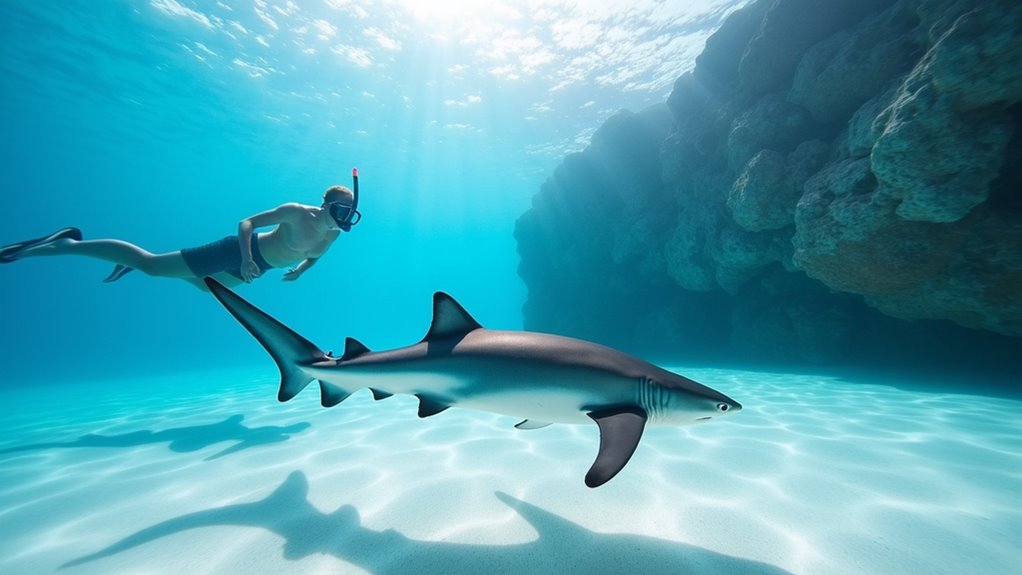
Mediterranean sharks lurk in Turkey's waters, but should swimmers worry about these misunderstood creatures?
Yes, Turkey’s waters are home to approximately 43 shark species in the Mediterranean and Aegean Seas. You’ll find rare visitors like juvenile great whites, critically endangered angel sharks, and various deep-water species. Most sharks stay in deeper offshore waters, making encounters at popular beaches extremely rare. Turkey has virtually no recorded unprovoked shark attacks, so you can swim with confidence. Learn which specific shark species inhabit these waters and why they’re increasingly threatened.
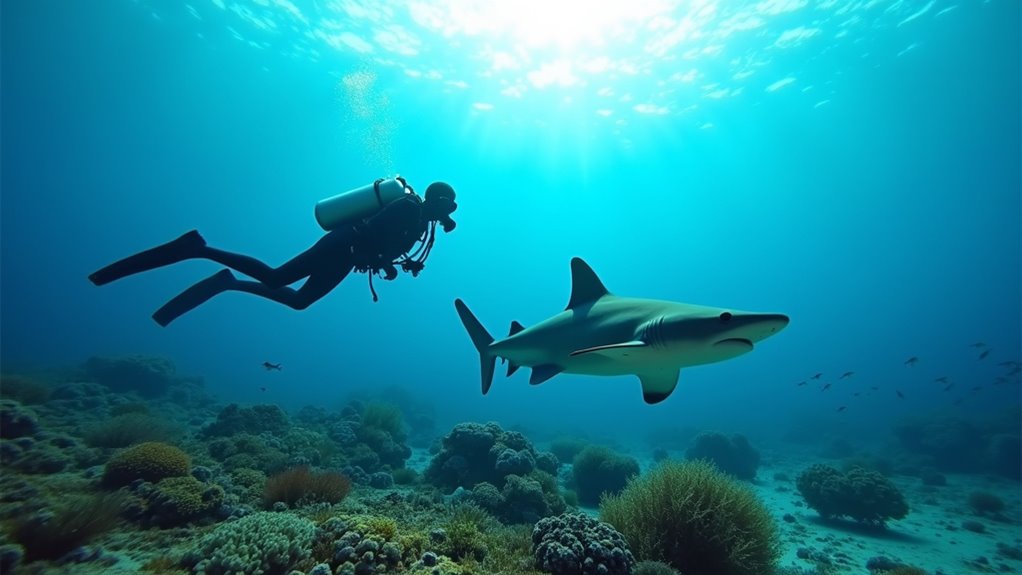
While many travelers associate Turkey with its stunning beaches and crystal-clear waters, few realize that these same waters are home to a diverse population of sharks. Turkey’s section of the Mediterranean Sea is part of a massive 2.5 million km² ecosystem that supports approximately 50 shark species.
Turkey’s Mediterranean waters harbor a surprising secret — a rich diversity of shark species beneath those idyllic tourist beaches.
The Turkish waters, particularly the north Aegean Sea, serve as indispensable nursery grounds for deep-water shark species. With average depths of 1,500 meters, this marine environment provides ideal conditions for various shark habitats, from shallow coastal areas to deep-water zones. Among the deep-sea inhabitants, the Velvet-Bellied Lanternshark uses bioluminescence for camouflage and communication in the dark depths.
You’ll find 43 shark species living in the Mediterranean, including hammerheads and blackmouth catsharks. Like the Nordic countries, Turkey offers visitors a unique blend of natural beauty both above and below the water’s surface.
Unfortunately, many of these magnificent creatures are critically endangered due to overfishing and habitat loss, prompting important conservation efforts.
Despite their fearsome reputation worldwide, great white sharks are remarkably uncommon visitors to Turkey’s coastal waters. Only 20 sightings were recorded between 1991-2020, making your chances of encountering one virtually nonexistent.
Most Turkish great whites are actually juveniles under 2 meters long, with Edremit Bay showing evidence of potential nursery activity. In July 2023, a juvenile great white shark was caught in fishing nets off Altınok coast and was identified as four days old.
The 2020 sighting off Enez coast marks the most recent confirmed occurrence, though a viral 2019 Nosset Beach video continues circulating on social media.
You’ll be relieved to know there have been zero unprovoked attacks on humans in Turkish waters. Many travelers who have previously enjoyed Stockholm’s attractions find Turkey’s shark-free beaches a compelling alternative for water activities. These apex predators typically prefer cooler, deeper waters and only occasionally venture into coastal zones during their Mediterranean migrations.
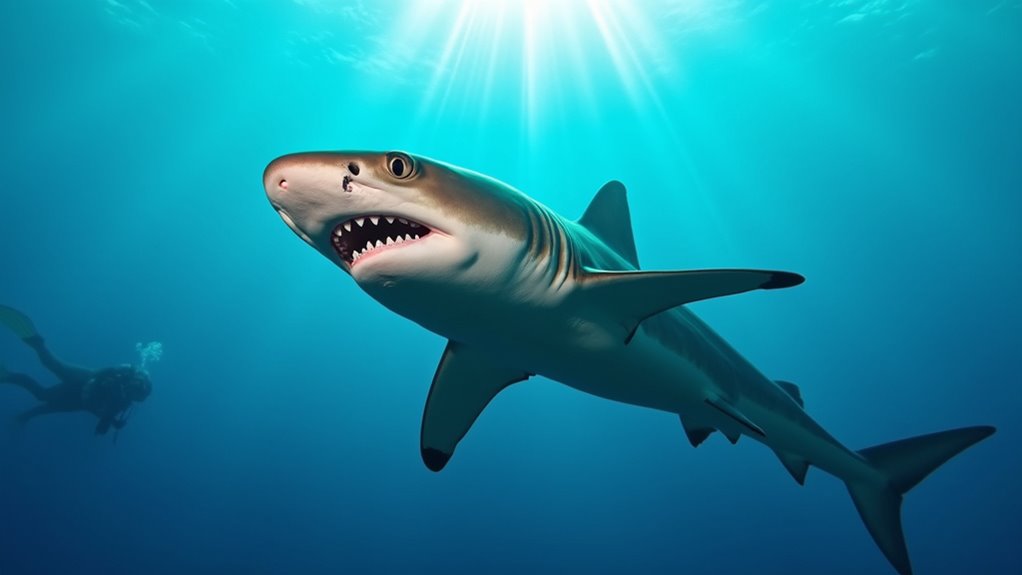
The sand tiger shark presents a striking paradox in Turkish waters: with its rows of jagged teeth perpetually visible beyond closed jaws, you’d expect aggression, yet this species ranks among the most docile sharks you might encounter.
Characterized by its sandy-colored body with reddish-brown spots and two similarly-sized dorsal fins positioned near its tail, this stocky shark once roamed Turkish coastal waters but has faced a troubling decline.
Despite being critically endangered globally, it’s now possibly extinct in the Mediterranean—with no confirmed sightings since 2003.
These nocturnal hunters use a unique buoyancy technique, gulping air to hover motionless near cave ceilings or shipwrecks. The scientific name Carcharias taurus was originally described by Constantine Rafinesque from a specimen caught off Sicily in the Mediterranean.
Unlike the vibrant snorkeling spots around Dubrovnik, Turkish waters now rarely offer sightings of these magnificent creatures in their natural habitat.
Their slow reproduction rate (only two pups every two years) has made them exceptionally vulnerable to bycatch and historical trophy hunting.
Once widespread throughout the Mediterranean and beyond, angel sharks now face a grim reality in Turkish waters as their populations have plummeted by a staggering 49% across their historical range.
You’ll find these distinctive flat-bodied sharks in Turkey’s sandy coastal habitats at depths up to 150m, including the Aegean Sea and Sea of Marmara.
Angel sharks grow impressively large, with females reaching up to 244cm. They’re ovoviviparous, with females giving birth to 7-25 pups every two years after an 8-10 month gestation.
These critically endangered creatures migrate between shallow nursery grounds and deeper waters, often crossing international boundaries. The WWF Mediterranean Marine Initiative works to protect these vulnerable sharks through sustainable management efforts across the region.
Fishing activities and habitat degradation pose the greatest threats to their survival, prompting global conservation efforts through the Angel Shark Conservation Network.
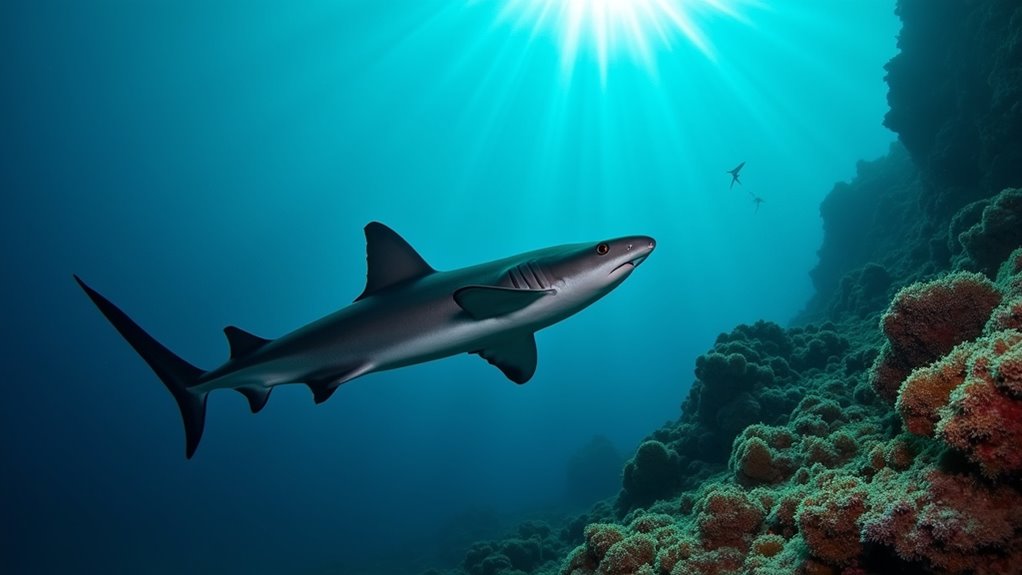
Far beneath the Aegean’s sun-dappled surface, you’ll find some of Turkey’s most mysterious shark inhabitants. These deep-sea specialists typically dwell at 200-1000+ meters, rarely interacting with humans or venturing into coastal zones.
Several notable species roam these depths, including the Little Gulper Shark (documented at 401 meters off Gökçeada in 2019), Angular Rough Shark, and occasional vagrant species like Sixgill Sharks.
These enigmatic denizens of the deep patrol Turkish waters, from Little Gulpers to rare Sixgills, hidden beyond the reach of sunlight.
These creatures have evolved remarkable adaptations—slow metabolisms, pressure tolerance, and specialized sensory systems to detect prey in their dark, cold-water habitats.
Unfortunately, many deep-water sharks face conservation challenges. Despite being classified as threatened globally, they receive minimal protection and are occasionally caught as bycatch in deep-sea trawling operations. The Mediterranean Sea, with its average depth of 1,500 meters, provides an ideal environment for these elusive shark species.
Both Mediterranean destinations like Greece and Croatia also host similar deep-water shark populations in their territorial waters.
Limited data exists due to their inaccessible habitats.
Despite what thriller movies might suggest, swimming in Turkey’s coastal waters carries minimal shark-related risks. With only four recorded shark attacks in Turkey’s history, your chances of an unpleasant encounter are extraordinarily low.
Most sharks in Turkish waters prefer deeper regions away from crowded beaches, hunting for fish rather than humans. When rare incidents do occur, they’re typically cases of mistaken identity rather than deliberate attacks. Popular tourist destinations like Antalya and Bodrum have documented shark sightings but extremely few negative interactions.
You’ll find no designated high-risk areas along Turkey’s coastline. The vastness of the Mediterranean further reduces the likelihood of shark encounters. This is quite different from European destinations like Norway which are known for their fjords rather than beach tourism.
Even with some species potentially increasing in number due to tuna farming activities, fatal incidents remain extremely rare. Beach safety measures exist primarily for other hazards, as sharks pose very little threat to visitors.
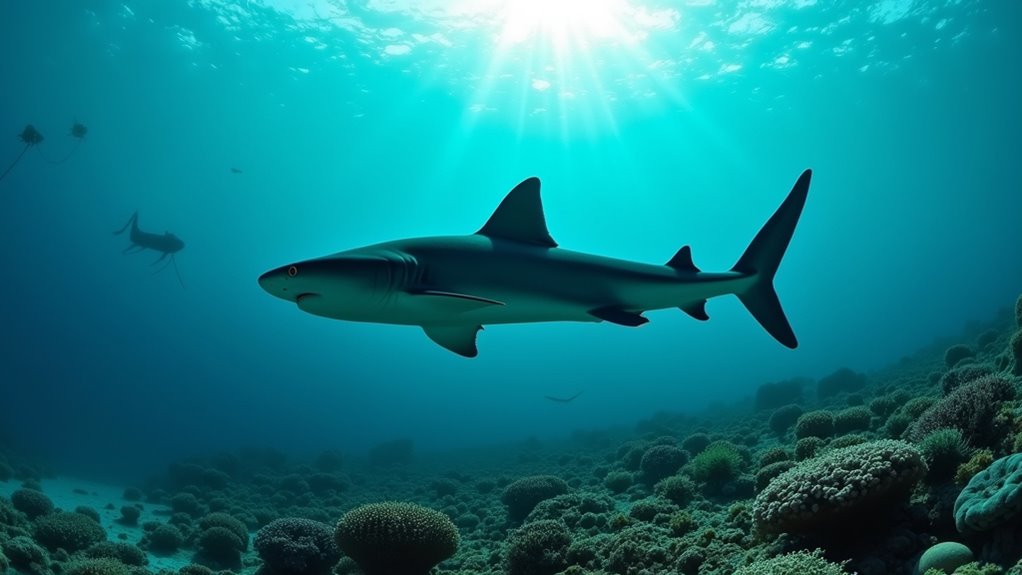
While Turkey’s waters host an impressive diversity of 41 shark species across 18 families, these magnificent creatures face mounting conservation challenges that threaten their survival.
Habitat degradation from coastal development and pollution particularly endangers critically endangered species like angel sharks, which have experienced range reductions of up to 58%. Fishing practices and gear continue to pose significant risks through bycatch and direct targeting. According to the latest updated checklist of sharks in the Sea of Marmara, Turkey, historical and taxonomic changes have been documented to assist future conservation studies.
The relentless assault of development and fishing practices pushes Turkey’s angel sharks to the brink of extinction in their shrinking habitat.
You’ll find conservation efforts hampered by insufficient data on population numbers and distribution patterns. Increased marine traffic and tourism add further pressure to already vulnerable shark habitats. For budget-conscious travelers, understanding the cost factors in coastal regions can help support responsible tourism that minimizes impact on marine ecosystems.
The hotel of Marine Protected Areas and Critical Angel Shark Areas (CASAs) offers hope, but effective implementation remains essential. Without proper enforcement of conservation policies and community engagement, Turkey’s sharks—especially the endangered angel and shortfin species—face an uncertain future.
Among the diverse shark species inhabiting Turkey’s waters, blue and blacktip sharks stand out as two distinctive open water predators you’ll encounter in the region.
Blue sharks prefer cooler, deeper waters and typically grow between 6-11 feet long. You’ll find them primarily along the coasts of France, Italy, and Greece within the Mediterranean.
In contrast, blacktip sharks favor shallow environments around coral reefs, bays, and lagoons, particularly near Turkish shores. These agile hunters, reaching 5-8 feet, are known for leaping out of water when pursuing prey.
While both species have different habitat preferences, they share a timid nature around humans.
The Mediterranean’s varied temperature ranges and abundant food sources create ideal conditions for these sharks, which adapt their migration patterns seasonally.
These sharks are rarely spotted near popular coastal destinations like Split in Croatia, where travelers often choose to vacation for its beautiful Adriatic beaches.
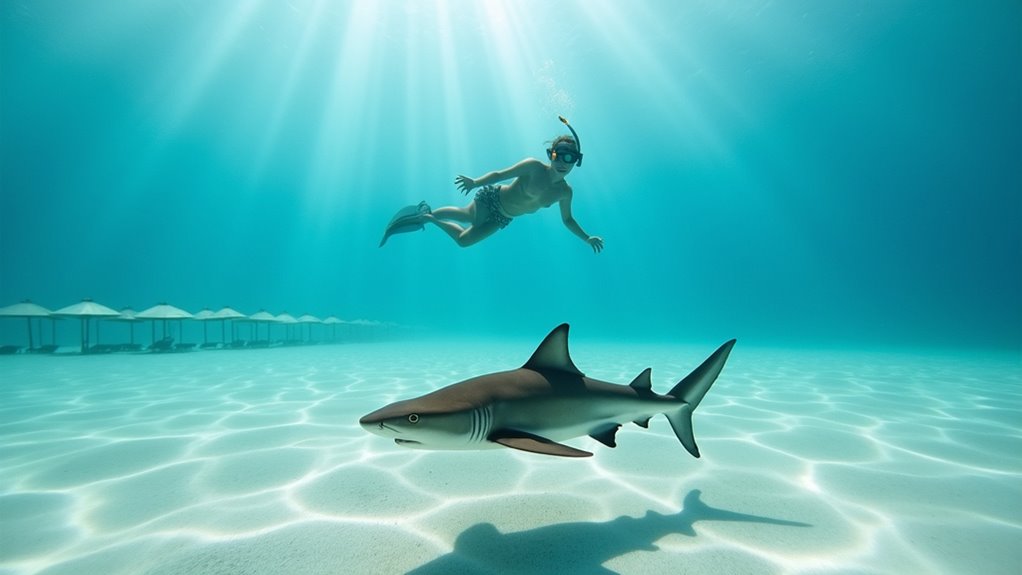
When visiting Turkey’s popular beach destinations, you’ll find a remarkable balance between human recreational activities and shark habitats that has resulted in an exceptionally safe environment for beachgoers. Shark attacks here are extremely rare—virtually unheard of compared to other coastal destinations worldwide.
Turkey’s beaches offer an exceptional safety record, with shark encounters virtually non-existent compared to other global coastal hotspots.
Despite the Mediterranean housing about 50 shark species, including some in the Aegean Sea bordering Turkey, encounters remain minimal. Sharks typically prefer areas with abundant fish and marine mammals, which aren’t common near Turkey’s busy beaches. If you’re deciding between destinations this year, Turkey offers safer beach options than many other global coastal regions.
While there aren’t extensive shark-specific safety measures in place, conservation efforts are growing as many Mediterranean shark species are critically endangered. Swimming in designated swimming areas is recommended as an additional safety precaution when enjoying Turkey’s coastal waters.
You’ll benefit from educational initiatives that promote awareness about marine life, helping maintain the peaceful coexistence that makes Turkey’s beaches so appealing.
You’ve glimpsed beneath Turkey’s azure waters, where ancient mariners once sailed above silent sharks. Like these seafarers who navigated uncertain depths with respect, you’ll find your beach vacation perfectly safe when you understand your finned neighbors. They’re not villains but vulnerable creatures struggling in their own story. Next time you’re swimming in Turkish waters, remember: you’re just a visitor in their diminishing kingdom.